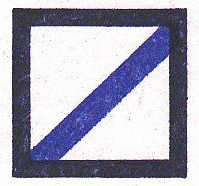These recollections of Ted Inge are edited from letters he wrote to John Fenton early in 1990 when Ted was 74 years of age. Some of his remarks show the tendency towards understatement and self-deprecation that is typical of one ex-serviceman in conversation with another.
I had a fairly comfortable landing at Courseulles. I did not stay on the beach as I was the “X” N.C.O. and the dump was a mile or so inland.
I was the only R.A.F. type on my L.S.I.1 All the remainder were Canadian assault troops and the only person I knew was a Major who, apparently, had been at Anzio. He was to do for the Army what I was to do for the R.A.F. i.e. set up an explosives dump.
As I say, the landing was not too bad. I had experienced worse on practice landings. When I got ashore the Canadians were still milling around in Courseulles. It was no place for us with just two S&W .380 between us.2 So I brewed up and the Major left me to recce, only to return hours later pushing a cycle with the news that he was setting off for his site. I decided that I would stay the night in the grounds of some chateau and push on in the morning light.
The rest of my Squadron were to have a terrible time, being kept off shore for three or four days, priority being given to fighting troops.3 I have no idea what time I actually landed but I was scheduled for H-Hour plus two hours and have always thought that I must have been one of the first of R.A.F. ground staff to land in France.
We collected two Croix de Guerre and I was lucky in the draw for Oak Leaves.4
Originally I was with No. 3 Embarkation Unit and it was there that I first met F/Lt Lofty Lawson. I left him and the comfort of civvy digs on Merseyside for the rigours of life with No. 2 Beach Sqdn. Imagine my surprise in finding myself posted to No. 89 Embarkation Unit, commanded by S/Ldr Lawson, after the initial few weeks of the invasion. After a few weeks at Arromanches I took a small detachment to Caen, subsequently joining up again with 89 E.U. at Calais. Senior N.C.O.s Fletcher, Clark, Fry and Blanchard are names I can recall. I worked with Sgt Ginger Clark after the war – we were both with British Airways. Long after the war my wife and I motored through Normandy and the little wooden hut that most of the S.N.C.O.s used at Arromanches was still there.
SUPPLEMENT TO THE LONDON GAZETTE, 1 JANUARY, 1946
Air Ministry, 1st January, 1946.
The KING has been graciously pleased to give orders for the publication of the names of the following personnel who have been mentioned in despatches:-
Sergeants-.
644104 E. G. INGE.
( See Gazette Issue 37407 at www.thegazette.co.uk )
- Landing Ship Infantry ↩︎
- Smith and Wesson revolvers ↩︎
- According to the Operations Record Book of No 2 R.A.F. Beach Squadron the landing of one party from 104 Beach Flight was delayed and so was that of most of the Squadron Headquarters personnel. The former were phased to land at H + 9 on D-Day but did not land until the morning of 8th June (D + 2). The latter were phased for landing at H + 7 on D-Day but did not land until about 1600 hours on 7th June (D + 1). These serious delays were, however, limited to only these elements of the Squadron. ↩︎
- By this Ted means he was Mentioned In Despatches – a single bronze oak leaf emblem worn on the ribbon of the War Medal 1939-45 signifies this award, which could be for gallantry in action or for other noteworthy service. ↩︎
